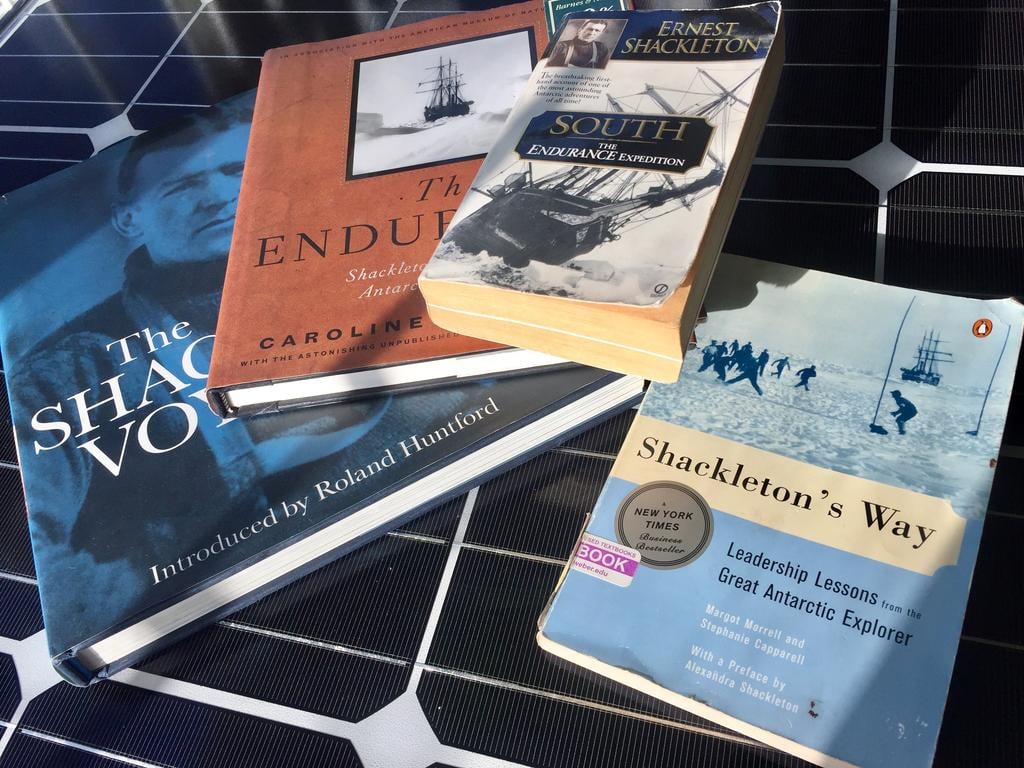
At the beginning of an MBA class, I was reviewing the syllabus and was particularly excited to notice one of the upcoming assignments. It was a case study of Antarctic explorer Sir Ernest Shackleton and his ill-fated Endurance Expedition.
Shackleton was a figure I’d been fascinated by for some time. In fact, I’d read three books about him already! (The 1st, 2nd, and 3rd from L pictured; rightmost was the class text. All recommended to those interested in learning more!)
Here’s a brief summary: Shackleton’s 1914 Antarctic Expedition headed for the South Pole aboard the Endurance. It was an attempt to make the first land crossing of the Antarctic. The ship became trapped and crushed by ice, ninety-seven nautical miles from the South Pole.
The crew drifted on ice, sailing in tiny open boats for months. After two years the ordeal was over. Miraculously, the entire crew survived.
That assignment left me with some insights that have stuck with me to this day. Over the last few months, especially, a few takeaways from that project have been on my mind.
Whether you’re leading your family or firm through uncertainty, consider my Top 3 of Shackleton’s leadership-in-crisis attributes:
1. Routine (Mission) equals stability; every person gets their daily tasks. If you’re working from home, continue to get up near your ‘work’ time. And ‘commute’ – yes, that often dreaded occurrence actually sets us up for the home-to-work transition. Therefore, if you’re still (or just occasionally) working from home, remember that just a fifteen-minute walk out of the house and back will tell your organism, ‘OK, it’s GO time’.I even heard a famous author comment that though he could work from anywhere, he decided to use the space above his home’s detached garage as his office. He leaves his house at eight in the morning and goes across the yard up into his office, and doesn’t return back home until later in the afternoon. That’s his routine, and it works.
2. Confidence: Exude strength and focus. Shackleton intended to get the whole job done. When he was forced to pivot away from traversing the Antarctic continent, he put all his strength into returning his crew safely. “He sought advice from his charges, but made the final decisions alone.” (M. Morrell and S. Capparell; Shackleton’s Way)His focus sometimes required doing nothing. One of the crews’ homes on the Antarctic ice was called Patience Camp. They stayed there for three months. Shackleton was aware that any other action would have wasted precious energy, considering the brief Antarctic summer of continually shifting ice flows. Better to choose a relatively large flow and stay put. Waiting for the oncoming colder weather allowed for a fixed position on surer footing. That call took confidence, but it was necessary to begin their journey to safety.
3. Empathy/Togetherness: When Shackleton would see a man struggling, everyone would get some kind of treat (hot tea, for example), so as not to single out the individual in pain. He wouldn’t allow his men to retreat directly to their cabin/tent following dinner; there’d be board games and singing. In that spirit, I’ve spent A LOT of evenings watching Disney’s “Raven’s Home” with my family over the past couple of months! (I know, not exactly roughing it - but it keeps up morale around here)
We look forward to things settling down. Let's maintain an unwavering focus on our mission, remain confident in each step, and remember that empathy is essential.





